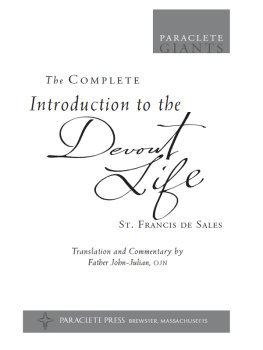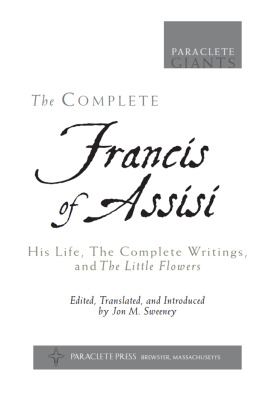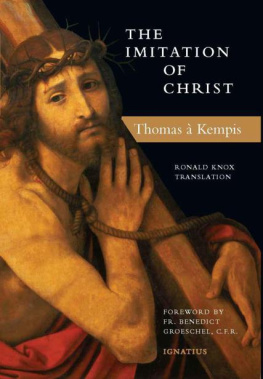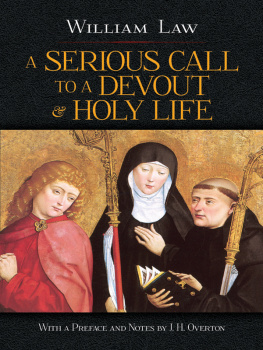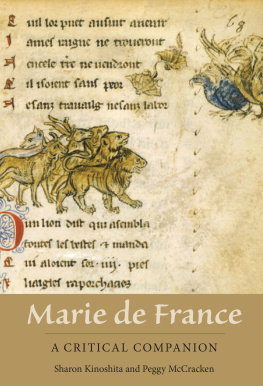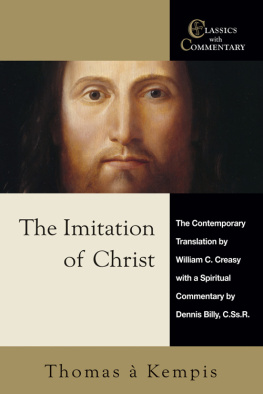
THE COMPLETE
INTRODUCTION TO THE
DEVOUT LIFE
PARACLETE
GIANTS
ABOUT THIS SERIES:
Each Paraclete Giant presents collected works of one of Christianitys greatest writersgiants of the faith. These essential volumes share the pivotal teachings of leading Christian figures throughout history with todays theological students and all people seeking spiritual wisdom.
Also in this Series
THE COMPLETE FNELON
Edited with translations by Robert J. Edmonson, CJ and Hal M. Helms
THE COMPLETE JULIAN OF NORWICH
Translation and commentary by Father John-Julian, OJN
THE COMPLETE THRSE OF LISIEUX
Edited with translations by Robert J. Edmonson, CJ
THE COMPLETE MADAME GUYON
Edited with translations by Rev. Nancy C. James, PhD
THE COMPLETE IMITATION OF CHRIST
Translation and commentary by Father John-Julian, OJN
For more information, visit www.paracletepress.com.
The COMPLETE
Introduction to the

ST. FRANCIS DE SALES
Translation and Commentary by
Father John-Julian, OJN
 | PARACLETE PRESS BREWSTER, MASSACHUSETTS |
2013 First Printing
The Complete Introduction to the Devout Life
Copyright 2013 by The Order of Julian of Norwich
ISBN 978-1-61261-235-5
The Paraclete Press name and logo (dove on cross) are trademarks of Paraclete Press, Inc.
Library of Congress Cataloging-in-Publication Data
Francis, de Sales, Saint, 1567-1622.
[Introduction la vie dvote. English]
The complete introduction to the devout life / Francis de Sales ; translation and commentary by Father John-Julian, OJN.
p. cm. (Paraclete giants)
ISBN 978-1-61261-235-5 (trade pbk.)
1. Meditations. I. John-Julian, Father, O.J.N., translator. II.Title.
BX2179.F8I54 2013
248.482dc23
2012051578
10 9 8 7 6 5 4 3 2 1
All rights reserved. No portion of this book may be reproduced, stored in an electronic retrieval system, or transmitted in any form or by any meanselectronic, mechanical, photocopy, recording, or any otherexcept for brief quotations in printed reviews, without the prior permission of the publisher.
Published by Paraclete Press
Brewster, Massachusetts
www.paracletepress.com
Printed in the United States of America
May it please God that this book, the most perfect of its kind in the opinion of contemporaries of the saint, be read now as it formerly was by practically every one. If this were done, Christian piety certainly would flourish the world over and the Church of God could rejoice in the assurance of a widespread attainment of holiness by her children.
POPE PIUS XI, Rerum Omnium Perturbationem, 1923
CONTENTS
TRANSLATORS INTRODUCTION |
|
PART THREE: Containing Much Advice Regarding the Practice of the Virtues |
|
PART FIVE: Containing Practices and Advice to Renew the Soul and Strengthen It in Devotion |
TRANSLATORS INTRODUCTION
T HE M AN
T he European Savoy is a peculiar territory. In the sixteenth century, its area straddled the western Alps and overlapped bits of what are now France, Switzerland, and Italy, and it included a Mediterranean port at Nice. Since the early fifteenth century it had been an independent duchy, a mini-nation, ruled by the Duke of Savoy, and because of its locationjust across the bay from Calvins Geneva and between Catholic France and Italyit was the scene of much religious disruption during the years following the Reformation. Franois de Sales, Lord of Boisy,
Franciss earliest education was in the hands of his young mother and the Abb Dage, who was to become Franciss tutor and remain his companion for over forty years. (His father considered this merely a boyish phase and still intended that his son have a career in public life.)
When Francis was fifteen, his father arranged for him to enter the College of Navarre in the University of Paris (because that was the college that had traditionally been attended by the noble families of Savoy). But Francis begged off and, with his mothers intercession, was allowed instead to enter the College of Clermontbecause it was supervised by the Jesuits and famous for both piety and academics. At the college, Francis did extremely well in the academic disciplines of philosophy and rhetoric (the latter clearly evident in the style and literary quality of his later writings). The study of theology and Scriptures was predictably his favorite, but in deference to his father (who still intended him for high social position) he took lessons in horsemanship, dancing, and fencing. He remained at the college for six years.
During his youth, the extreme Calvinist version of the Augustinian doctrine of predestination had become central in Protestant teaching (that is, that ones state All fear and despair left him, and he was at peace. From that time on, Francis credited the Blessed Virgins prayers with saving him from total desolation and heresy, and soon thereafter he made a vow of lifelong chastity.
In 1588, Francis was called home by his father and dispatched to the University of Padua to study jurisprudence. He remained there for four yearsagain excelling in his studies. He came under the influence of the humanist Jesuit Antonio Possevino, who remained a lifelong friend and advisor. In the summer of 1590 an epidemic of typhoid hit Padua. Francis became seriously ill and expected to die (to the extent that he willed his body to the medical school, saying, At least I will offer something to the public since I have offered nothing else in my life Finally, at the age of twenty-four, he was awarded a doctoral degree in both law and theology.
After graduation, in 1592, Francis made a pilgrimage to the Holy House at Loreto,mother and a few close friends knew of Franciss hope and intention to enter a life of religion, and he dreaded the thought of telling his father.
At just this time, the provost
At this point we must understand that during the upheavals of the Protestant Reformation, John Calvin had established his headquarters in Geneva and eventually persuaded the city council to outlaw Catholicism, the practice of any Catholic rites, and the presence of ordained Catholics in the city. This meant that the Catholic bishop of Genevawhile retaining his titlewas forced to establish a cathedral-in-exile twenty-five miles away in Annecy, across the border in the Savoy. It was there that Francis had become Provost.
Meanwhile, in the Chablaisthe northernmost province of the Duchy of Savoythe Protestants had also gained control. The Duke of Savoy wanted the province returned to Catholicism, but the first missionary sent to the area had been driven out by Calvinist soldiers. Francis and his cousin Louis volunteered themselves, and in 1594 the grateful bishop assigned them as missionaries to the Chablais.with Franciss sermons and published under the title of The Controversies, also known as Open Letter to Protestants.)
In the first seven months, the priests made only one convert. Then they began to preach in the public squares and invited Calvinists to debate with them publicly. In their second winter in the Chablais, they made nearly two hundred converts. At about that time, at great personal risk to himself and at the bidding of the pope, Francis traveled secretly to Geneva three times to meet with Thodore de Bze (Calvins successor and the leader of the Geneva Protestants) to discuss possibilities of reconciliation. The discussions between the thirty-year-old Francis and the seventy-year-old de Bze were irenic and amiable but produced no conversion.
Next page
